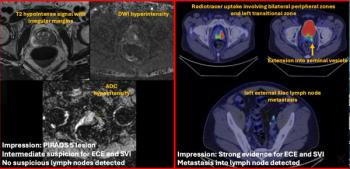
Ecstatic German informatics group wins rare top-ranking poster award
Unbridled joy took hold in the normally subdued poster hall on Wednesday afternoon when the first purple summa cum laude rosette given by the RSNA since 1998 was bestowed upon an elated team of IT specialists.
Unbridled joy took hold in the normally subdued poster hall on Wednesday afternoon when the first purple summa cum laude rosette given by the RSNA since 1998 was bestowed upon an elated team of IT specialists.
“This is a great honor for us,” said lead author Prof. Oliver Bott, Ph.D., a medical informatics specialist from the University of Applied Sciences and Arts in Hannover, Germany. “When we saw the award on our exhibit, we just looked at each other and went ‘WOW’! It was so unexpected.”
The team has developed new software for simulation-based C-arm fluoroscopy training to help improve image quality and radiation protection (see below for further reading). C-arm fluoroscopy is very operator-dependent, but the package enables nonhazardous, lifelike training while providing extra information, such as through the visualization of scattered radiation, during a simulated procedure.
The tool is of great value to technologists and nurses who perform fluoroscopy during trauma and orthopedic surgery and who have traditionally undergone their training on actual patients, said Bott, who last presented at the RSNA meeting in 2004. He hopes to make the software available commercially next year, but in the meantime it will be used later in December at a trauma congress in Davos, Switzerland.
The authors of another 11 exhibits received magna cum laude rosettes, the second category of awards.
Researchers from Massachusetts General Hospital in Boston won a prize for their exhibit of common skin findings on breast MRI, which tend to be overlooked, are vital to detect, and are not well described in the literature, according to lead author Sirishma Kalli.
“As breast MRI is used with increasing frequency in both the screening and diagnostic settings, a better understanding of which lesions do and do not require further evaluation will be progressively important,” Kalli said. “Radiologists should thoroughly assess any skin and superficial findings and their differential diagnoses.”
MRI alone may not provide definitive etiologies of these lesions. To establish the lesions’ importance, radiologists should use mammography, ultrasound, a physical examination, consultations with physicians or dermatologists, and, when necessary, pathological correlation from biopsy in conjunction with MRI findings.
The prize-winning exhibit by Dr. Kamran Shah, a radiologist from the University of Maryland in Baltimore, focused on the complications and postoperative appearance of traumatic facial fractures. Radiologists can provide better information to surgeons if they can understand the impact of fractures on facial buttress anatomy, recognize the common fracture complexes, and identify potential complications, Shah said.
Liver Doppler made simple was the theme of the poster by Dr. Dean McNaughton, a radiologist from the University of Iowa. He thinks the understanding of normal liver Doppler waveforms (arteries and veins) requires conceptualization of flow direction and dynamics. There are a limited number of abnormal (pathologic) liver Doppler patterns to remember, and when radiologists have learned these patterns, they can easily reason through the vast majority of pathologic states affecting the liver, he said.
Other magna cum laude winners were Dr. Y. Geffroy from Paris; Dr. R.F. Riascos from Galveston, TX; Dr. W.L. Nowinski from Singapore; Dr. F. Rajouyan from Bethesda, MD; Dr. B.N. Hatton from St. Petersburg, FL; Dr. D. Biyyam from Seattle, WA; and Dr. P.J. Peller from Rochester, MN.
FURTHER READING ON SUMMA CUM LAUDE POSTER:
- Bott OJ, Teistler M, Duwenkamp C, et al.
VirtX – evaluation of a computer-based training system for mobile C-arm systems. In Trauma and Orthopedic Surgery. Methods Inf Med 2008;47(3):270-278.
- Bott OJ, Wagner M, Duwenkamp C, et al.
Improving education on C-arm operation and radiation protection with a computer-based training and simulation system. Int J CARS 2009 June;4(4):399-407.
Newsletter
Stay at the forefront of radiology with the Diagnostic Imaging newsletter, delivering the latest news, clinical insights, and imaging advancements for today’s radiologists.




























